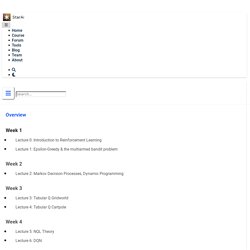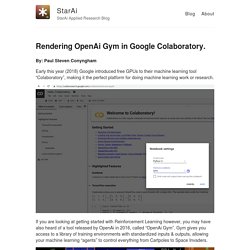

AlphaGo Zero Explained In One Diagram. Recently Google DeepMind announced AlphaGo Zero — an extraordinary achievement that has shown how it is possible to train an agent to a superhuman level in the highly complex and challenging domain of Go, ‘tabula rasa’ — that is, from a blank slate, with no human expert play used as training data.

It thrashed the previous reincarnation 100–0, using only 4TPUs instead of 48TPUs and a single neural network instead of two. The paper that the cheat sheet is based on was published in Nature and is available here. I highly recommend you read it, as it explains in detail how deep learning and Monte Carlo Tree Search are combined to produce a powerful reinforcement learning algorithm. Hopefully you find the AlphaGo Zero cheat sheet useful — let me know if you find any typos or have questions about anything in the document. Training intelligent adversaries using self-play with ML-Agents - Unity Technologies Blog. In the latest release of the ML-Agents Toolkit (v0.14), we have added a self-play feature that provides the capability to train competitive agents in adversarial games (as in zero-sum games, where one agent’s gain is exactly the other agent’s loss).

In this blog post, we provide an overview of self-play and demonstrate how it enables stable and effective training on the Soccer demo environment in the ML-Agents Toolkit. The Tennis and Soccer example environments of the Unity ML-Agents Toolkit pit agents against one another as adversaries. Training agents in this type of adversarial scenario can be quite challenging.
Teaching. UCL Course on RL Advanced Topics 2015 (COMPM050/COMPGI13) Reinforcement Learning Contact: d.silver@cs.ucl.ac.uk.

Write an AI to win at Pong from scratch with Reinforcement Learning. We’re now going to follow the code in me_pong.py.

Please keep it open and read along! The code starts here: def main(): Initialization First, let’s use OpenAI Gym to make a game environment and get our very first image of the game. StarAi Deep Reinforcement Learning Course. Welcome to the StarAi Deep Reinforcement Learning course The goal of this course is two fold: Most RL courses come at the material from a highly mathematical approach.

We aim to explain essential Reinforcement Learning concepts such as value based methods using a fundamentally human tool - stories.We believe what you cannot create, you do not understand. We have provided easy to use exercises, with answers, to reinforce your learning. Deep Reinforcement Learning: Playing CartPole through Asynchronous Advantage Actor Critic (A3C)… By Raymond Yuan, Software Engineering Intern In this tutorial we will learn how to train a model that is able to win at the simple game CartPole using deep reinforcement learning.

We’ll use tf.keras and OpenAI’s gym to train an agent using a technique known as Asynchronous Advantage Actor Critic (A3C). Reinforcement learning has been receiving an enormous amount of attention, but what is it exactly? Reinforcement learning is an area of machine learning that involves agents that should take certain actions from within an environment to maximize or attain some reward. In the process, we’ll build practical experience and develop intuition around the following concepts: The Promise of Hierarchical Reinforcement Learning. Update: Jürgen Schmidhuber kindly suggested some corrections concerning the early work on intrinsic motivation, subgoal discovery and artificial curiosity since 1990, which I have incorporated and expanded.

Suppose your friend just baked and shared an excellent cake with you, and you would like to know its recipe. It might seem that it should be very easy for your friend to just tell you how to cook the cake — that it should be easy for him to get across the recipe. But this is a subtler task than you might think; how detailed should the instructions be? Deep Reinforcement Learning with TensorFlow 2.0. In this tutorial I will showcase the upcoming TensorFlow 2.0 features through the lense of deep reinforcement learning (DRL) by implementing an advantage actor-critic (A2C) agent to solve the classic CartPole-v0 environment.

While the goal is to showcase TensorFlow 2.0, I will do my best to make the DRL aspect approachable as well, including a brief overview of the field. In fact since the main focus of the 2.0 release is making developers’ lives easier, it’s a great time to get into DRL with TensorFlow - our full agent source is under 150 lines! Rendering OpenAi Gym in Google Colaboratory. – StarAi – StarAi Applied Research Blog. By: Paul Steven Conyngham Early this year (2018) Google introduced free GPUs to their machine learning tool “Colaboratory”, making it the perfect platform for doing machine learning work or research.

If you are looking at getting started with Reinforcement Learning however, you may have also heard of a tool released by OpenAi in 2016, called “OpenAi Gym”. Welcome to Spinning Up in Deep RL! — Spinning Up documentation. Sutton & Barto Book: Reinforcement Learning: An Introduction. Second Edition (see herefor the first edition) MIT Press, Cambridge, MA, 2018 Buy from Amazon ErrataFull Pdf pdf without margins (good for ipad)New Code Old Code Solutions -- send in your solutions for a chapter, get the official ones back (currently incomplete)Teaching AidsLiterature sources cited in the book Latex Notation -- Want to use the book's notation in your own work?

Download this .sty file and this example of its use Help out! If you enjoyed the book, why not give back to the community? Roboschool. We are releasing Roboschool: open-source software for robot simulation, integrated with OpenAI Gym. Three control policies running on three different robots, racing each other in Roboschool. You can re-enact this scene by running agent_zoo/demo_race1.py. Each time you run the script, a random set of robots appears. Roboschool provides new OpenAI Gym environments for controlling robots in simulation. Undefined - Model Zoo. Reinforcement Learning - Monte Carlo Methods · Ray. Reinforcement Learning from scratch – Insight Data. Deep Reinforcement Learning: Pong from Pixels. This is a long overdue blog post on Reinforcement Learning (RL). RL is hot! You may have noticed that computers can now automatically learn to play ATARI games (from raw game pixels!)
, they are beating world champions at Go, simulated quadrupeds are learning to run and leap, and robots are learning how to perform complex manipulation tasks that defy explicit programming. A (Long) Peek into Reinforcement Learning. In this post, we are gonna briefly go over the field of Reinforcement Learning (RL), from fundamental concepts to classic algorithms. Hopefully, this review is helpful enough so that newbies would not get lost in specialized terms and jargons while starting. [WARNING] This is a long read. A couple of exciting news in Artificial Intelligence (AI) has just happened in recent years. AlphaGo defeated the best professional human player in the game of Go. Very soon the extended algorithm AlphaGo Zero beat AlphaGo by 100-0 without supervised learning on human knowledge. What is Reinforcement Learning?
Say, we have an agent in an unknown environment and this agent can obtain some rewards by interacting with the environment. Fig. 1. The goal of Reinforcement Learning (RL) is to learn a good strategy for the agent from experimental trials and relative simple feedback received. Key Concepts Now Let’s formally define a set of key concepts in RL. The agent is acting in an environment. Fig. 2. Policy.